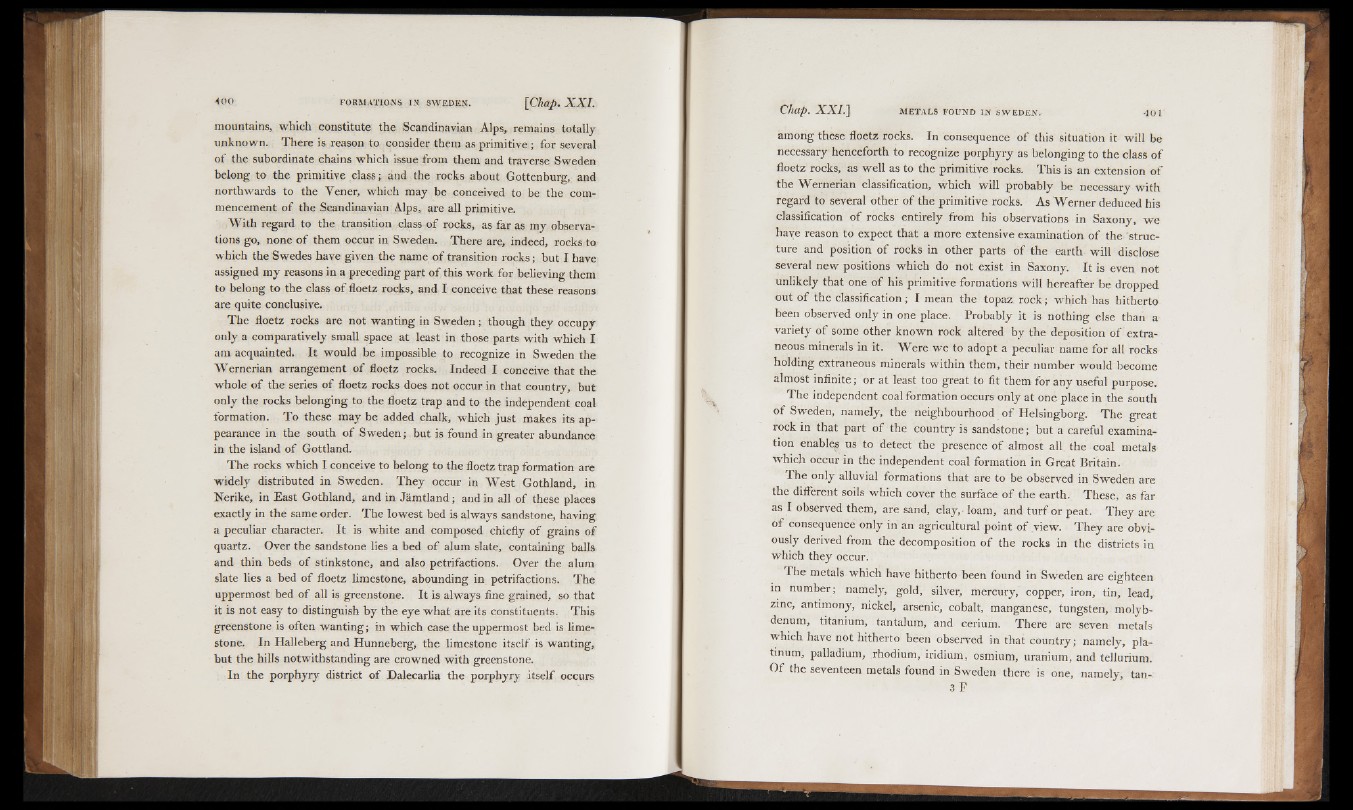
mountains, which constitute the Scandinavian Alps, remains totally
unknown. There is reason to consider them as primitive; for several
o f the subordinate chains which issue from them and traverse Sweden
belong to the primitive class; and the rocks about Gottenburg, and
northwards to the Yener, which may be conceived to be the commencement
o f the Scandinavian Alps, are all primitive.
With regard to the transition class o f rocks, as far as my observations
go, none o f them occur in Sweden. There are, indeed, rocks to
which the Swedes have given the name o f transition rocks; but I have
assigned my reasons in a preceding part of this work for believing them
to belong to the class o f floetz rocks, and I conceive that these reasons
are quite conclusive.
The floetz rocks are not wanting in Sweden; though they occupy
only a comparatively small space at least in those parts with which I
am acquainted. It would be impossible to recognize in Sweden the
Wernerian arrangement o f floetz rocks. Indeed I conceive that the
whole o f the series of floetz rocks does not occur in that country, but
only the rocks belonging to the floetz trap and to the independent coal
formation. To these may be added chalk, which just makes its appearance
in the south o f Sweden; but is found in greater abundance
in the island o f Gottland.
The rocks which 1 conceive to belong to the floetz trap formation are
widely distributed in Sweden. They occur in West Gothland, in
Nerike, in East Gothland, and in Jamtland; and in all of these places
exactly in the same order. The lowest bed is always sandstone, having
a peculiar character. It is white and composed chiefly o f grains of
quartz. Over the sandstone lies a bed o f alum slate, containing balls
and thin beds o f stinkstone, and also petrifactions. Over the alum
slate lies a bed o f floetz limestone, abounding in petrifactions. The
uppermost bed of all is greenstone. It is always fine grained, so that
it is not easy to distinguish by the eye what are its constituents. This
greenstone is often wanting; in which case the uppermost bed is limestone.
In Halleberg and Hunneberg, the limestone itself is wanting,
but the hills notwithstanding are crowned with greenstone.
In the porphyry district o f Dalecarlia the porphyry itself occurs
among these floetz rocks. In consequence o f this situation it will be
necessary henceforth to recognize porphyry as belonging to the class o f
floetz rocks, as well as to the primitive rocks. This is an extension o f
the Wernerian classification, which will probably be necessary with
regard to several other of the primitive rocks. As Werner deduced his
classification o f rocks entirely from his observations in Saxony, we
have reason to expect that a more extensive examination o f the ‘structure
and position o f rocks in other parts of the earth will disclose
several new positions which do not exist in Saxony. It is even not
unlikely that one of his primitive formations will hereafter be dropped
out of the classification; I mean the topaz rock; which has hitherto
been observed only in one place. Probably it is nothing else than a
variety of some other known rock altered by the deposition of extraneous
minerals in it. Were we to adopt a peculiar name for all rocks
holding extraneous minerals within them, their number would become
almost infinite; or at least too great to fit them for any useful purpose.
The independent coal formation occurs only at one place in the south
of Sweden, namely, the neighbourhood o f Helsingborg. The great
rock in that part of the country is sandstone; but a careful examination
enables us to detect the presence of almost all the coal metals
which occur in the independent coal formation in Great Britain.
The only alluvial formations that are to be observed in Sweden are
the different soils which cover the surface o f the earth. These, as far
as I observed them, are sand, clay, 'loam, and turf or peat. They are
o f consequence only in an agricultural point o f view. They are obviously
derived from the decomposition o f the rocks in the districts in
which they occur.
The metals which have hitherto been found in Sweden are eighteen
in number; namely, gold, silver, mercury, copper, iron, tin, lead,
zinc, antimony, nickel, arsenic, cobalt, manganese, tungsten, molybdenum,
titanium, tantalum, and cerium. There are seven metals
which have not hitherto been observed in that country; namely, platinum,
palladium, rhodium, iridium, osmium, uranium, and tellurium.
Of the seventeen metals found in Sweden there is one, namely, tan-
3 F